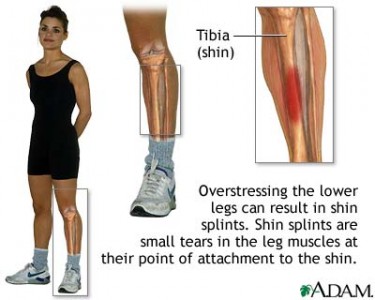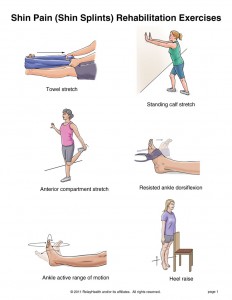There are no products for this injury yet.
(tibial stress syndrome)
This is the most common injury in, especially long-distance, runners. The direct reason of pain is overusing bone tissue and inflammation of the periosteal sleeve of tissue surrounding the tibia. The injury is mostly connected with: tibialis anterior, tibialis posterior, and soleus muscles. Clinicists claim, that the athletes are determined biomechanically sometimes, because of flat or with too high arch or too pronated feet. This faulty posture leads to less shocks absorptions during trains and overuse the muscles and the periosteal sleeve.
Exercises
1) Towel stretch:
– sit on the floor with straighten legs
– loop the towel around your feet
– now pull the towel toward your body keeping leg still straighten
– hold it for 20 seconds with tighten calf muscles and rest
– repeat exercise 10 times
2) Standing calf stretch:
– stand your face to the wall and rest straighten arms on it
– put your injured leg back and straight with your heel on the floor and bend a little opposite knee
– move closer to the wall to feel stretch in the back of calf of your injured leg
– hold it for 20 seconds and rest
– practice exercise 10 times
3) Anterior compartment stretch:
– stand next to the wall (to support yourself)
– bend the knee of injured leg and hold its foot
– close your foot to buttock as much as possible
– hold position for 30 seconds and rest it
– repeat exercise 15 times
4) Resisted ankle dorsiflexion:
– sit on the floor with straighten legs
– loop one end of the tubing around the foot of your injured leg
– the other end of the tubing tie e.g. to the door
– now flex your foot toward your body and
– hold it for 5 seconds and get back slowly
– repeat exercise 30 times
5) Ankle active range of motion:
– sit on the floor with straighten legs
– flex your toes in injured leg toward your body and get back slowly
– repeat this exercise 30 times
– now move your foot the circles in clockwise and counterclockwise direction without raising your heel!
– repeat exercise 30 times for each direction
6) Heel raise:
– stand on your feet next to the chair (to support yourself if it’s necessary)
– stand on your toes slowly and hold position for 10 seconds
– now return slowly
– practice exercise 15 times



